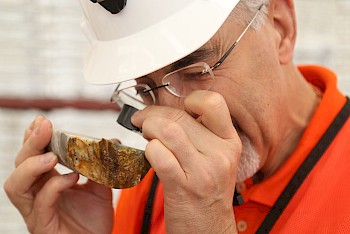-
Back to the media page m
 These three types of studies simply reflect different confidence levels of evaluating a mining project. The confidence levels relate to geological knowledge about the deposit as well as the economic estimates such as capital and operating costs that are required to exploit the deposit. After the initial discovery, a mineral deposit is usually delineated by exploration drilling to provide an understanding of its geometry, resources, tonnes, grades and recoveries. The first study is a conceptual PEA, also called a scoping study, to define the scope of the project, including preliminary engineering alternatives for developing the mine and processing the ore, broad estimates of capital and operating costs, and other economic parameters.
These three types of studies simply reflect different confidence levels of evaluating a mining project. The confidence levels relate to geological knowledge about the deposit as well as the economic estimates such as capital and operating costs that are required to exploit the deposit. After the initial discovery, a mineral deposit is usually delineated by exploration drilling to provide an understanding of its geometry, resources, tonnes, grades and recoveries. The first study is a conceptual PEA, also called a scoping study, to define the scope of the project, including preliminary engineering alternatives for developing the mine and processing the ore, broad estimates of capital and operating costs, and other economic parameters.A PEA tries to answer the question, “how best can this deposit be exploited to maximize its economic returns?” Unlike more advanced studies, a PEA can use inferred resources for its operational and financial modeling so long as one has a reasonable expectation the outcome will be a profitable mine. A PEA is normally followed by a PFS and, if financing with debt, a FFS. A PEA rarely forms the basis for a production decision because of the higher degree of unknown risks and costs and timelines.
A PFS is a more advanced study that uses only reserves and measured and indicated resources and involves more detailed engineering in order to optimize the alternatives for developing the mine and processing the ore. It also uses tighter estimates of capital and operating costs and other economic parameters by comparing them to recent examples. A PFS is usually followed by a FFS, but if financing with equity, can sometimes be used as the basis for a production decision if the economics are particularly robust or the costing is at a FFS level.
A FFS is the most advanced study that typically only uses reserves and involves definitive engineering and detailed costing based on actual bids where possible instead of estimates. An FFS is considered essential in order to finance larger, more complex, capital intensive, lower return mining projects, or if financing with banks, in which case it is often called a bankable feasibility study (BFS).
After each purchase of Endeavour’s first three mines in Mexico, we did not publish any economic studies because each of our three mines were already permitted, built and operating so the risks and costs were well defined, and we financed them with equity. We did however complete internal studies to satisfy our management team and board of directors each time we committed to invest substantial capital to buy, build or expand the mines.
We recently resumed our focus on building new mines to drive organic growth so we chose to publish economic studies on our next two mines. Last year, we published a robust PEA (See Endeavour News Release dated March 27, 2017) on the El Compas Mine in Zacatecas, which is currently being commissioned to be our fourth mine.vIt was already largely permitted and we signed a long term lease on a dormant but fully permitted government plant, so the project was sufficiently de-risked and small enough for us to make a production decision in August 2017 based on the PEA. We have since updated and optimized the mine plan and financial model (see Endeavour News Release dated February 20, 2018) and are currently in the process of commissioning the mine, plant and tailings facilities.
Our exciting Terronera Project is a virgin discovery in the historic San Sebastian mining district in Jalisco State that has the potential to become our fifth, largest and lowest cost mine. We released a positive PFS (see Endeavour News Release date April 3, 2017) and received the government mine and plant permits last year, and we are now awaiting the final dumps and tailings permits. Most recently, we published an updated PFS for Terronera, modelling some of the lowest operating costs in the silver mining sector (see Endeavour News Release dated August 30, 2018). The 2018 PFS shows significantly higher revenues, EBITDA, free cash flow, mine life and NPV with significantly lower cash costs and all-in sustaining costs per silver oz and will provide the basis for a production decision and subsequent project financing.
© 2024 Endeavour Silver Corp.
All rights reserved.

